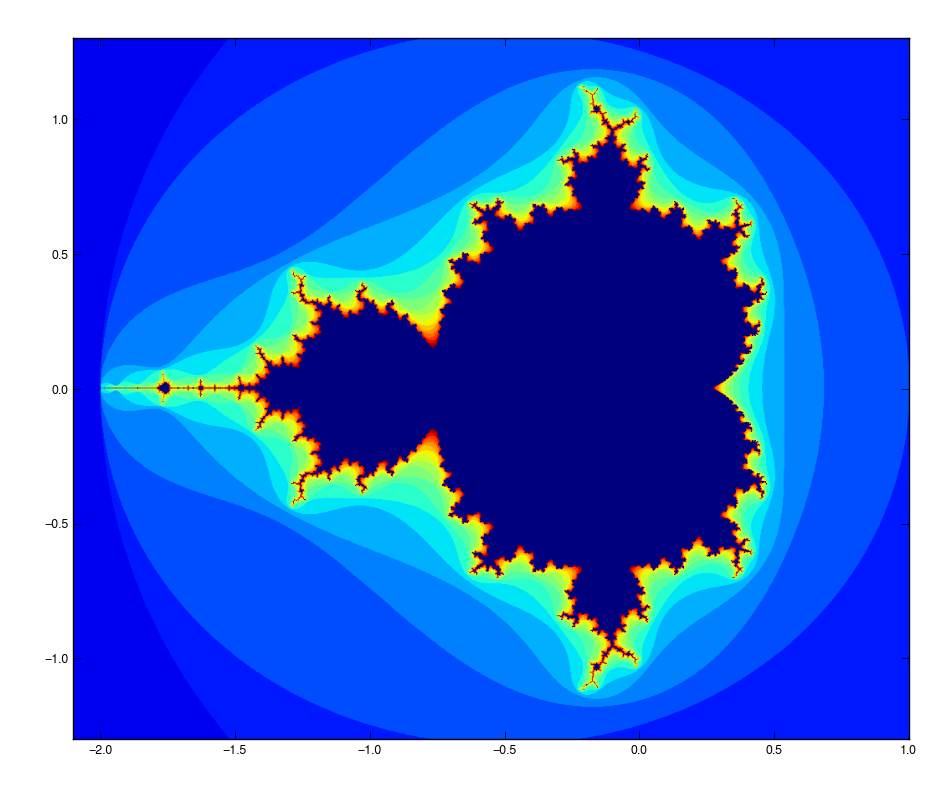Calling Fortran from Python
(edited )
The way I use here to call Fortran from Python is to make the Fortran code callable from C and then bind that with Cython (version 0.19.1). This is what is recommended in "Fortran best practices". There are other ways, like F2Py and fwrap, but (I think) the former struggles with modern Fortran and the latter's development has stalled. Maybe another avenue to pursue could be CFFI. In fact, all this linking Python to compiled code seems to be quite in a state of flux at the moment and this could be outdated soon (or is already!).
I build on the code of Calling Fortran from C. The idea is to call
the subroutine c_calc_num_iter in mandel\_wrap.f90 from Cython.
Once that is done, then a call from Python is trivial. The code I use
here can be accessed with
git clone https://maurow@bitbucket.org/maurow/mauro_learning_fortran.git cd mauro_learning_fortran git checkout v0.2.1
and is in the folder mandel/.
Cython
The cython wrapper program wraps the same mandel\_wrap.f90 as I used
in Calling Fortran from C.
pymandel.pyx
import numpy as np
# this defines the external function's interface. Why the out needs
# to be defined as 'int *out' and not 'int **out' I do not know...
cdef extern:
void c_calc_num_iter(int nre, double *re, int nim, double *im,
int itermax, double escape, int *out)
def calc_num_iter(double[::1] re not None,
double[::1] im not None,
int itermax=20, double escape=2.):
cdef int nre, nim
nre = len(re)
nim = len(im)
# initialize the output array with cython so Python manages the
# memory:
out = np.empty((nre, nim), dtype=np.int32)
cdef int [:,::1] res = out
c_calc_num_iter(nre, &re[0], nim, &im[0],
itermax, escape, &res[0,0])
return out
Notes:
- the
cdef externdefines the function signature of the "c" function. In this case the signature is provided by using Fortran'siso_c_bindingmodule inmandel_wrap.f90. I don't know why the last argument, a 2D array in Fortran, is just a simple pointer (int *out) as opposed to a pointer to a pointer (int **out). - This implementation uses memoryviews which makes the code nicer than the older numpy buffer style.
outis a Python variable, so Python manages the memory, which is good.cdef int [:,::1] resmakes a C-style array, which is good as that is whats returned frommandel_wrap.f90.
Compiling the Cython extension module
Compilation was the trickiest part!
First make the the *.o files of the Fortran code:
gfortran -fPIC -c mandel.f90 mandel_wrap.f90
The -fPIC is needed.
Then, for cython compilation, it is usually best to make a setup.py
file:
from distutils.core import setup
from distutils.extension import Extension
from Cython.Distutils import build_ext
import numpy
npy_include_dir = numpy.get_include()
ext_modules = [Extension("mandel", ["pymandel.pyx"],
include_dirs = [npy_include_dir],
extra_objects=["mandel.o", "mandel_wrap.o"])]
setup(name = 'Mandelbrot fractals',
cmdclass = {'build_ext': build_ext},
ext_modules = ext_modules)
The none-standard parts is to include the extra *.o files. I think
depending on the Fortran code there might be some libraries missing
which can be included with libraries["somelib"]=. To figure out
which other libraries are needed, run the last gcc command which
running python setup.py build_ext --inplace spits out but replace
gcc with (1) gcc -v and (2) gfortran -v and see what the
difference are.
Running in Python
Now Python can be used to plot the Mandelbrot set:
test.py
import numpy as np import pylab as plt import mandel as md nn = 1000 re = np.linspace(-2.1,1,nn) im = np.linspace(-1.3,1.3,nn+1) out = md.calc_num_iter(re, im) # calling Fortran plt.imshow(out.T, extent=(re[0],re[-1],im[0],im[-1])) plt.show()

Summary of steps
- write Fortran module
- write wrapper in Fortran to make function available in C
- make a Cython wrapper, wrapping between the Fortran/C function and Python
- call the thing from Python
Seems quite convoluted…